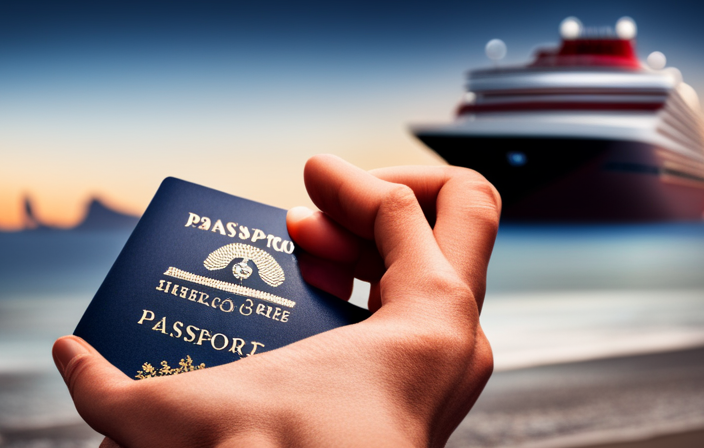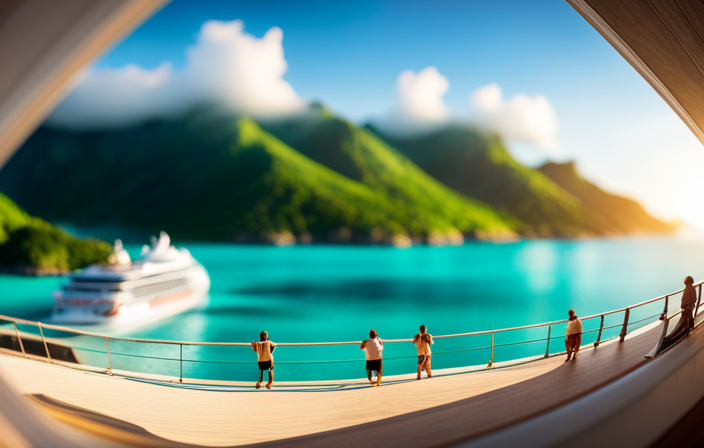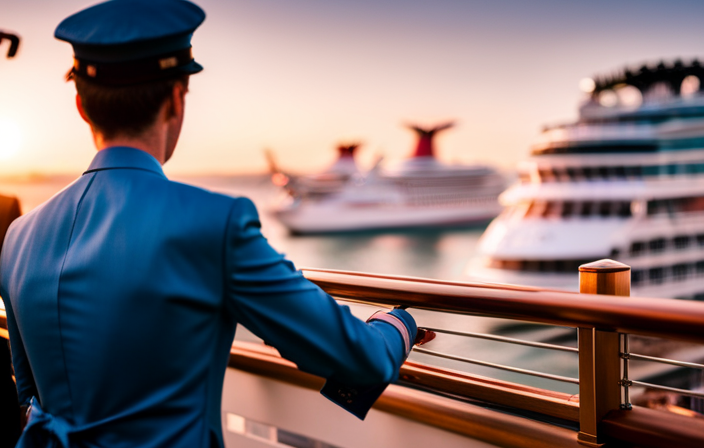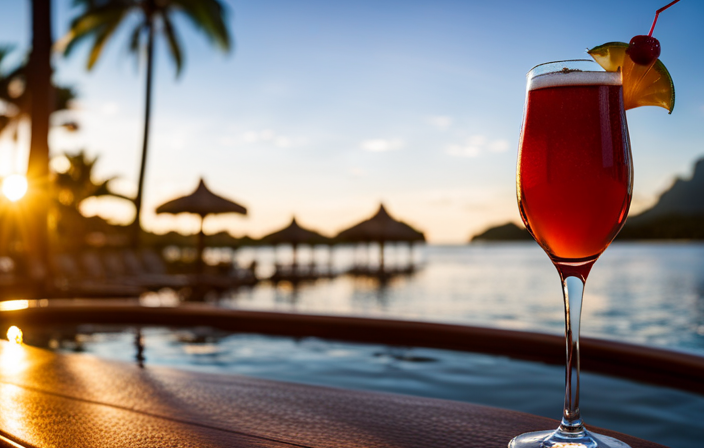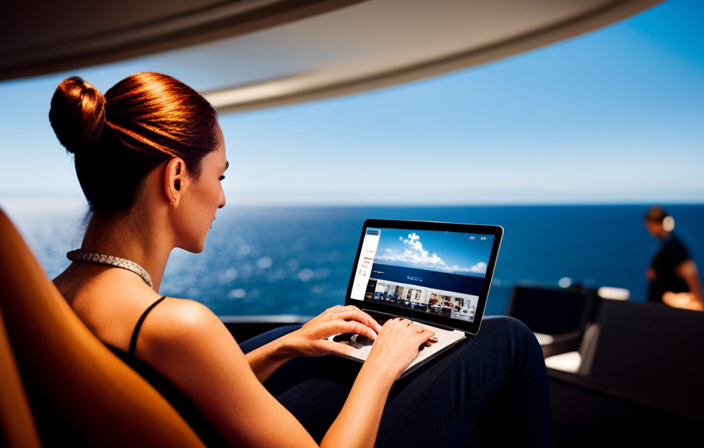Onboard Experience
Why Is Norovirus Common on Cruise Ships
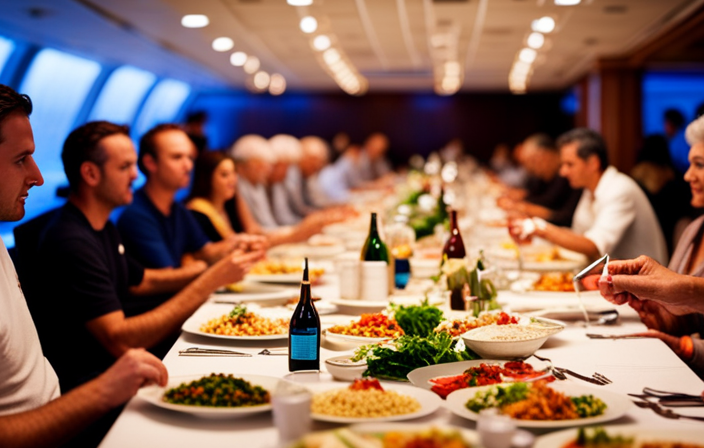
As a frequent cruiser, I’ve always wondered about the common presence of norovirus on these luxurious ships. This worry is not mine alone, leading to a more detailed investigation into this highly contagious virus.
In this article, we will explore the factors that contribute to norovirus outbreaks on cruise ships, such as high population density and shared facilities. We’ll also discuss the challenges in controlling its spread and the efforts made by public health officials.
So, let’s dive in and uncover the reasons behind the common occurrence of norovirus on cruise ships.
Key Takeaways
- Norovirus spreads easily on cruise ships due to the fecal-oral route and contaminated food and water.
- Factors contributing to norovirus outbreaks on cruise ships include lack of effective quarantine protocols, inconsistent implementation of transmission prevention strategies, high population density, close quarters, and limited sanitation opportunities.
- Challenges in controlling norovirus spread on cruise ships include inadequate hygiene practices, high passenger turnover, shared dining facilities, and the constant influx and departure of passengers.
- Environmental conditions, such as the survival of norovirus on surfaces and in water, as well as its transmission through respiratory droplets, contribute to the risk of norovirus outbreaks on cruise ships.
The Nature of Norovirus
Norovirus is a highly contagious virus that causes stomach and intestinal inflammation. It is important to understand the factors affecting its transmission and the prevention strategies to combat its spread.
Norovirus is primarily transmitted through the fecal-oral route, meaning it can spread when infected individuals do not practice proper hand hygiene after using the bathroom. Additionally, contaminated food and water can serve as vehicles for transmission.
Prevention strategies include frequent handwashing with soap and water, especially before eating or preparing food, and after using the bathroom. Thoroughly cooking food and avoiding cross-contamination between raw and cooked foods is also crucial. Proper sanitation of surfaces and disinfection of contaminated areas are essential in preventing norovirus outbreaks.
Understanding these factors and implementing effective prevention strategies is key in reducing the spread of norovirus.
Now, let’s explore the factors contributing to norovirus outbreaks.
Factors Contributing to Norovirus Outbreaks
To avoid norovirus outbreaks, it’s important to frequently wash your hands and practice good hygiene while on board. However, there are other factors that contribute to the prevalence of norovirus on cruise ships.
One such factor is the lack of effective quarantine protocols. When a passenger or crew member is infected with norovirus, it is crucial to isolate them and prevent further transmission. Unfortunately, some cruise ships do not have proper quarantine measures in place, allowing the virus to spread rapidly among the passengers and staff.
Additionally, transmission prevention strategies, such as thorough cleaning and disinfection of common areas, are not always implemented consistently. This further facilitates the spread of norovirus.
With these factors in mind, it is evident that the high population density on cruise ships plays a significant role in the frequent outbreaks of norovirus.
High Population Density on Cruise Ships
Close quarters on cruise ships facilitate the transmission of norovirus. This is due to the proximity of individuals and the ease with which the virus can spread through respiratory droplets and contaminated surfaces.
With thousands of passengers and crew members in close proximity, it becomes difficult to contain the virus and prevent its spread.
Additionally, limited sanitation opportunities increase the risk of norovirus outbreaks on cruise ships. This is because proper hand hygiene and disinfection practices may not be consistently followed. As a result, the virus can persist and infect more individuals.
Close Quarters Facilitate Transmission
Due to the tight living spaces on cruise ships, it’s easier for norovirus to spread among passengers and crew members. The close quarters provide an ideal environment for the virus to thrive and transmit from person to person. Here are some reasons why the close quarters facilitate transmission:
-
Limited personal space: Passengers and crew members often share small cabins, making it difficult to maintain proper hygiene and avoid close contact with infected individuals.
-
Shared facilities: Common areas such as dining halls, entertainment venues, and recreational facilities increase the likelihood of virus transmission through contaminated surfaces and close proximity.
The transmission of norovirus on cruise ships has a significant impact on public health. Outbreaks can affect a large number of individuals within a short period, leading to severe illness and potential complications. Additionally, the confined nature of the ship can hinder effective transmission prevention measures, further exacerbating the spread.
As we explore the next section, it becomes evident that the limited sanitation opportunities on cruise ships increase the risk of norovirus outbreaks.
Limited Sanitation Opportunities Increase Risk
Make sure you take advantage of every available opportunity to sanitize your hands and surfaces, as the limited sanitation options on board put you at a higher risk for infection. On cruise ships, the ability to maintain proper hygiene is often compromised due to a variety of factors. For instance, the table below illustrates the limited sanitation opportunities on board and the potential risks associated with them:
| Limited Sanitation Opportunities | Increased Risk |
|---|---|
| Insufficient handwashing stations | Inadequate hand hygiene |
| Crowded common areas | Higher chance of person-to-person transmission |
| Shared bathroom facilities | Contamination of surfaces |
These factors create an environment where norovirus can easily spread. Insufficient handwashing stations make it challenging for passengers and crew members to thoroughly clean their hands, increasing the risk of transmitting the virus. Crowded common areas provide ample opportunities for person-to-person transmission through close contact. Additionally, shared bathroom facilities can become contaminated with norovirus, leading to the spread of the virus through contact with contaminated surfaces.
As we delve into the next section discussing shared facilities and contaminated surfaces, it becomes evident that these conditions further contribute to the prevalence of norovirus on cruise ships.
Shared Facilities and Contaminated Surfaces
To prevent the spread of norovirus on cruise ships, you should regularly clean and disinfect shared facilities and surfaces. Contaminated water sources and transmission through air particles are two key factors contributing to the prevalence of norovirus on cruise ships.
Norovirus can be present in water sources, such as swimming pools or hot tubs, if they are not properly treated or maintained. Additionally, the virus can be transmitted through tiny particles in the air when an infected person vomits or has diarrhea. These particles can settle on surfaces and contaminate them, leading to further spread of the virus.
Therefore, it is crucial to regularly clean and disinfect common areas, such as dining areas, restrooms, and handrails, to prevent norovirus from spreading. However, despite these preventive measures, challenges in controlling norovirus spread still persist.
Challenges in Controlling Norovirus Spread
Inadequate hygiene practices, high passenger turnover, and shared dining facilities are three key factors that contribute to the challenges in controlling the spread of norovirus on cruise ships.
Firstly, many passengers may not adhere to proper hand hygiene, which can facilitate the transmission of the virus.
Secondly, the constant influx and departure of passengers on cruise ships create a dynamic environment where the virus can easily be introduced and spread.
Lastly, shared dining facilities, where large numbers of people gather to eat, can serve as hotspots for norovirus transmission, especially if proper cleaning and disinfection protocols are not followed.
Understanding and addressing these factors is crucial in implementing effective measures to prevent and control norovirus outbreaks on cruise ships.
Inadequate Hygiene Practices
One reason norovirus is common on cruise ships is because passengers and crew members often don’t practice proper hygiene. Inadequate cleaning and lack of awareness contribute to the spread of this highly contagious virus. Here are three key factors that contribute to the inadequate hygiene practices on board:
-
Insufficient cleaning protocols: Cruise ships have a high passenger turnover, making it challenging to maintain cleanliness. Inadequate cleaning of surfaces and shared spaces can allow the virus to thrive and spread easily.
-
Lack of hand hygiene: Many passengers and crew members fail to follow proper handwashing techniques, including using soap and water for at least 20 seconds. This allows the virus to transfer from contaminated surfaces to hands and then to the mouth, leading to infection.
-
Limited awareness: Some individuals may not be aware of the importance of practicing good hygiene to prevent the spread of norovirus. Lack of knowledge about the virus and its transmission can contribute to the continued spread on cruise ships.
With inadequate hygiene practices in place, it is not surprising that norovirus outbreaks occur frequently on cruise ships. The combination of these factors creates an environment conducive to the rapid spread of the virus.
High Passenger Turnover
With so many passengers coming and going, it’s no wonder that cruise ships have a high turnover rate. This constant flow of people creates a challenging environment when it comes to maintaining proper sanitation practices. Limited opportunities for passengers to practice good hygiene can contribute to the spread of illnesses like norovirus.
Cruise ships are essentially floating cities, accommodating thousands of passengers at a time. However, the limited number of sanitation stations can make it difficult for passengers to wash their hands regularly and thoroughly. Additionally, the close proximity of passengers in confined spaces increases the risk of person-to-person transmission.
These factors, combined with the high passenger turnover, create an ideal environment for the rapid spread of norovirus and other infectious diseases.
As we explore further, we will delve into another crucial aspect of cruise ship hygiene: the shared dining facilities.
Shared Dining Facilities
The close proximity of passengers in confined spaces on cruise ships can increase the risk of person-to-person transmission, which is why shared dining facilities are a concern. Limited dining options and the large number of people using these facilities can contribute to the spread of norovirus.
Research has shown that contaminated food is a common source of norovirus outbreaks on cruise ships. In a study conducted by the Centers for Disease Control and Prevention (CDC), it was found that 75% of norovirus outbreaks on cruise ships were caused by contaminated food. This highlights the importance of proper food handling and sanitation practices in preventing the transmission of norovirus.
Inadequate hand hygiene practices also play a significant role in the spread of norovirus, which will be discussed in the next section.
Inadequate Hand Hygiene Practices
Norovirus is often spread on cruise ships due to people not practicing adequate hand hygiene. This is a significant factor in the transmission of the virus, as it can easily be passed from person to person through contaminated hands. The lack of proper handwashing techniques and hygiene education contributes to the rapid spread of norovirus on cruise ships.
Here are some reasons why inadequate hand hygiene practices contribute to the spread of norovirus on cruise ships:
-
Insufficient handwashing: Many people do not wash their hands for the recommended duration of at least 20 seconds, or they may not wash their hands at all.
-
Improper handwashing technique: Some individuals may not use soap or fail to cover all surfaces of their hands, including the backs, between fingers, and under nails.
-
Lack of hand sanitizer use: Hand sanitizers can be effective in killing norovirus, but not everyone uses them regularly.
-
Poor hand hygiene education: Some passengers may not be aware of the importance of hand hygiene in preventing the spread of norovirus.
With inadequate hand hygiene practices being a significant contributor to norovirus transmission on cruise ships, it is crucial to address this issue to prevent further outbreaks.
Transitioning to the next section about foodborne transmission of norovirus, it is essential to understand another route by which the virus can spread onboard.
Foodborne Transmission of Norovirus
When it comes to the foodborne transmission of norovirus, there are several key points to consider.
First, contaminated food sources can play a significant role in spreading the virus. Whether it’s contaminated water used in food preparation or raw ingredients that carry the virus, these sources can easily contaminate the final product.
Second, inadequate food handling practices can also contribute to the transmission of norovirus. From improper hand hygiene to cross-contamination between raw and cooked foods, these practices can introduce the virus into the food supply chain.
Contaminated Food Sources
Contaminated food sources can contribute to the prevalence of norovirus on cruise ships. Norovirus is a highly contagious virus that causes gastroenteritis, leading to symptoms like vomiting, diarrhea, and abdominal pain. It is responsible for a significant number of foodborne illnesses worldwide.
Foodborne transmission occurs when the virus is present in contaminated food or water and is ingested by individuals. On cruise ships, where large numbers of people gather in close quarters, the risk of norovirus transmission is heightened.
Contaminated food sources, such as raw or undercooked shellfish, fruits, vegetables, and contaminated water used for cooking or drinking, can introduce the virus into the ship’s food supply. This highlights the importance of proper food handling and hygiene practices to prevent the spread of the virus among passengers and crew members.
Inadequate food handling can further exacerbate the prevalence of norovirus on cruise ships.
Inadequate Food Handling
To prevent the spread of the illness, you should always practice proper food handling techniques on a cruise ship. The following food handling practices and sanitation measures are essential to ensure the safety and well-being of passengers:
-
Handwashing: Regular and thorough handwashing with soap and water is crucial before and after handling food. This helps to eliminate any potential pathogens that may be present.
-
Proper storage: Food should be stored at appropriate temperatures to prevent bacterial growth. Refrigerated items must be kept below 40°F, and hot foods should be maintained above 140°F.
-
Cross-contamination prevention: To avoid the transfer of bacteria from one food to another, separate raw and cooked foods and use different utensils and cutting boards.
-
Regular cleaning and sanitizing: All food preparation surfaces, utensils, and equipment should be cleaned and sanitized regularly to minimize the risk of contamination.
Lack of Proper Sanitation
Inadequate food handling is not the only reason why norovirus is common on cruise ships. Another significant factor is the lack of proper sanitation practices.
Cruise ships are like floating cities with thousands of passengers and crew members living in close quarters. This crowded environment makes it easier for the virus to spread. Despite efforts to maintain cleanliness, it is challenging to control the transmission of norovirus in such a confined space.
Many surfaces, such as handrails, doorknobs, and dining areas, can become contaminated, allowing the virus to persist and infect more individuals. Proper sanitation practices, including frequent cleaning and disinfection of surfaces, proper hand hygiene, and isolation protocols for infected individuals, are crucial for disease prevention on cruise ships.
However, even with these measures in place, the impact of close contact and socialization cannot be overlooked.
Impact of Close Contact and Socialization
Close contact and socialization on cruise ships contribute to the high prevalence of norovirus. The impact of socialization cannot be underestimated when it comes to the transmission risks of this highly contagious virus.
Cruise ships are known for their close quarters and crowded spaces, making it easy for norovirus to spread from person to person. When people gather in dining areas, lounges, or participate in group activities, they are unknowingly creating opportunities for the virus to pass from one individual to another.
Additionally, the nature of cruise ship travel involves people from different regions and backgrounds coming together, increasing the chances of introducing new strains of the virus.
Understanding the role of close contact and socialization is crucial in preventing and controlling norovirus outbreaks on cruise ships.
This leads us to the next section, where we will explore the environmental conditions favoring norovirus survival.
Environmental Conditions Favoring Norovirus Survival
When you’re in confined spaces with many people, such as on a cruise ship, it’s important to be aware of the environmental conditions that can support the survival of norovirus. Norovirus is notorious for its ability to persist in various environments.
Studies have shown that it can survive on surfaces for up to several days, especially on hard surfaces like stainless steel and plastic. Additionally, the virus can remain infectious in water for extended periods of time. This means that even if a contaminated surface or water source has been cleaned, there is still a risk of transmission if proper disinfection measures are not taken.
Furthermore, norovirus can spread through respiratory droplets, making it highly transmissible in crowded spaces like cruise ship cabins and dining areas. This highlights the importance of implementing effective cleaning and hygiene protocols to minimize the risk of norovirus transmission on cruise ships.
With these environmental conditions in mind, it becomes crucial to understand the limited quarantine measures that are often in place on cruise ships.
Limited Quarantine Measures on Cruise Ships
It’s important to understand the limited quarantine measures in place on cruise ships to effectively minimize the risk of transmission. The limited medical resources available on these vessels make it challenging to implement comprehensive quarantine protocols.
Cruise ships often have limited medical staff and facilities, which can hinder the ability to isolate and treat infected individuals effectively. This limited capacity puts a strain on the cruise ship industry as outbreaks of norovirus can negatively impact their reputation and profitability.
The industry is constantly working to improve these measures, but the confined nature of cruise ships makes it difficult to completely eradicate the risk of transmission. Nonetheless, cruise lines are taking steps to mitigate the spread of norovirus and ensure the safety of their passengers and crew.
Speaking of crew and norovirus transmission…
Cruise Ship Crew and Norovirus Transmission
In my previous section, I discussed the limited quarantine measures on cruise ships, which can contribute to the spread of norovirus. Now, I want to shift the focus to the health of the cruise ship crew and the strategies in place to prevent norovirus transmission.
Ensuring the health of the crew is crucial in preventing the spread of norovirus on cruise ships. Cruise lines have implemented strict policies to maintain crew health, including regular hand hygiene training, monitoring of symptoms, and isolation of ill crew members. Additionally, crew members are required to follow strict food handling and preparation protocols to reduce the risk of contamination.
These prevention strategies play a vital role in minimizing norovirus outbreaks onboard. However, it is essential to understand that despite these measures, norovirus can still be introduced to the ship through various sources, including infected passengers, contaminated food or water, and even shore excursions.
Transitioning into the subsequent section about cruise ship itineraries and norovirus risk, it is necessary to consider how different destinations and activities can influence the likelihood of norovirus outbreaks.
Cruise Ship Itineraries and Norovirus Risk
To minimize the risk of norovirus outbreaks, you should consider how different destinations and activities on your cruise itinerary may influence the likelihood of transmission. Cruise ship itineraries play a significant role in the prevention of norovirus outbreaks. Research has shown that certain destinations and activities are more prone to norovirus transmission than others.
For example, crowded ports and excursions that involve close contact with local populations can increase the risk of exposure to the virus. Additionally, onboard activities such as buffets and shared recreational spaces can also contribute to the spread of norovirus. These findings have had a significant impact on the cruise industry, as outbreaks can result in negative publicity and financial losses.
Therefore, cruise lines have implemented measures to mitigate these risks, such as improved sanitation practices and increased passenger education. By considering these factors, passengers can make informed decisions to minimize their chances of contracting norovirus during their cruise.
Transitioning into the next section about public health efforts to prevent norovirus outbreaks, it is important to note that these efforts go beyond individual actions and involve coordinated strategies to safeguard public health.
Public Health Efforts to Prevent Norovirus Outbreaks
By following proper hygiene practices and staying informed about public health guidelines, you can actively contribute to the prevention of norovirus outbreaks. Public health strategies play a crucial role in outbreak management, focusing on both prevention and control measures. These strategies include promoting hand hygiene, implementing proper food safety practices, and conducting thorough environmental cleaning and disinfection. By adhering to these measures, individuals can reduce the risk of norovirus transmission and protect themselves and others from infection.
Moreover, cruise ships often have strict protocols in place to ensure the safety of passengers and crew members. These protocols may include pre-boarding health screenings, onboard medical facilities, and isolation procedures in case of an outbreak. By implementing these public health strategies, cruise ships can effectively manage norovirus outbreaks and minimize their impact on passengers and crew members.
Moving forward, it is essential to highlight the importance of surveillance and reporting in detecting and responding to norovirus outbreaks.
Importance of Surveillance and Reporting
Make sure you are vigilant about surveillance and reporting, as it plays a crucial role in detecting and responding to outbreaks. Effective surveillance systems and reporting procedures are essential in identifying and monitoring the occurrence of norovirus on cruise ships.
By collecting and analyzing data on cases and symptoms, public health authorities can identify patterns and trends, allowing for early detection and intervention. Surveillance systems rely on surveillance officers and healthcare professionals on board who are trained to promptly report any suspected cases. This timely reporting enables public health agencies to implement appropriate control measures, such as isolation of affected individuals and enhanced cleaning protocols.
It is through these surveillance systems and reporting procedures that outbreaks can be contained and the spread of norovirus minimized.
Now, let’s move on to recommendations for cruise ship passengers and crew to prevent the transmission of norovirus.
Recommendations for Cruise Ship Passengers and Crew
When it comes to preventing norovirus transmission on cruise ships, there are several key points to consider.
First, implementing effective hygiene practices on board is crucial. This includes frequent handwashing, proper sanitization of surfaces, and ensuring food safety protocols are followed.
Additionally, vaccination requirements and recommendations can play a significant role in reducing the risk of norovirus outbreaks on cruises, as vaccinations can help to boost immunity and prevent the spread of the virus.
Preventing Norovirus Transmission
One way to prevent the transmission of norovirus on cruise ships is by regularly disinfecting common areas. Maintaining cleanliness is crucial in preventing the spread of this highly contagious virus. The importance of cleanliness cannot be overstated when it comes to norovirus prevention measures.
By disinfecting surfaces such as handrails, door handles, and dining areas, the risk of transmission can be significantly reduced. Ensuring that crew members follow strict cleaning protocols and using effective disinfectants are essential in maintaining a hygienic environment on board.
Additionally, promoting proper hand hygiene among passengers and crew members through education and readily available hand sanitizers can further prevent the spread of norovirus. By implementing these preventive measures, cruise ships can create a safer and healthier environment for all on board, minimizing the risk of norovirus outbreaks.
Transitioning into the next section about hygiene practices on board, it is important to consider additional measures that can be taken to prevent the spread of norovirus.
Hygiene Practices on Board
Maintaining cleanliness and promoting good hand hygiene are essential for preventing the spread of norovirus on board. Improving hygiene practices can have a significant impact on public health and reduce the risk of norovirus outbreaks.
Cruise ships are known to be susceptible to norovirus due to the close proximity of passengers and crew members, making it crucial to implement effective hygiene measures. Regular handwashing with soap and water, especially before eating and after using the restroom, is vital in preventing norovirus transmission.
Additionally, proper cleaning and disinfection of high-touch surfaces, such as handrails and doorknobs, can help eliminate the virus. By prioritizing hygiene practices and implementing robust protocols, cruise lines can minimize the risk of norovirus outbreaks and enhance the overall health and safety of passengers and crew members.
As we move into the next section on vaccination requirements and recommendations, it is important to consider the additional measures that can be taken to further protect against norovirus.
Vaccination Requirements and Recommendations
To protect yourself and others from norovirus, make sure you check the vaccination requirements and recommendations before boarding the ship. Vaccinations are an important tool in preventing the spread of norovirus, a highly contagious gastrointestinal virus that can cause severe symptoms. Here are three key points to consider:
-
Vaccination effectiveness: Vaccines can significantly reduce the risk of contracting norovirus. Studies have shown that vaccinated individuals have a lower likelihood of getting sick and spreading the virus to others.
-
Potential side effects: Like any medication, vaccines can have side effects. However, the side effects of norovirus vaccines are generally mild and temporary, such as soreness at the injection site or a low-grade fever. Severe adverse reactions are extremely rare.
-
Consult with healthcare professionals: Before getting vaccinated, it is important to consult with your healthcare provider. They can provide personalized advice based on your medical history and any specific concerns you may have.
Frequently Asked Questions
How Long Does Norovirus Survive on Surfaces?
Norovirus can survive on surfaces for days, making it highly transmissible. Its ability to persist on surfaces contributes to its common occurrence on cruise ships, where close quarters and shared facilities facilitate transmission.
Can Norovirus Be Transmitted Through the Air?
Yes, norovirus can be transmitted through the air. It spreads easily in close quarters like cruise ships. To prevent airborne transmission, proper ventilation and hand hygiene are crucial.
Are There Any Specific Foods That Are More Likely to Be Contaminated With Norovirus?
Specific foods, such as raw shellfish, leafy greens, and fresh fruits, are more likely to be contaminated with norovirus. Proper food safety measures, like thorough cooking and hand hygiene, are essential in preventing foodborne illnesses on cruise ships.
How Effective Are the Quarantine Measures on Cruise Ships in Preventing Norovirus Outbreaks?
Quarantine measures on cruise ships can be effective in preventing norovirus outbreaks. Hand sanitizers play a crucial role in reducing the spread of the virus, and the diligence of crew members is key in maintaining proper sanitation practices.
What Steps Can Cruise Ship Passengers Take to Protect Themselves From Norovirus?
To protect myself from norovirus on a cruise ship, I can take steps like washing my hands frequently, avoiding touching my face, and avoiding close contact with sick individuals. Common symptoms of norovirus infection include vomiting and diarrhea.
Conclusion
In conclusion, the prevalence of norovirus on cruise ships can be attributed to various factors. These factors include the nature of the virus, high population density, shared facilities, and contaminated surfaces. Controlling the spread of norovirus on cruise ships can be challenging due to the close proximity of passengers and crew members.
However, public health efforts have been implemented to prevent outbreaks. These efforts include surveillance and reporting. For example, in a recent case study, a cruise ship successfully contained a norovirus outbreak. They did this by implementing strict hygiene protocols and isolating affected individuals.
It is crucial for both passengers and crew to follow recommendations to minimize the risk of norovirus transmission. These recommendations include frequent handwashing and avoiding shared utensils.
Alfons is the visionary leader and driving force behind Voyager Info’s success. As the Editor in Chief, he brings a wealth of experience and an unwavering passion for travel to the helm of our cruise-centric platform.
With a lifelong fascination for exploring new horizons, Alfons discovered his love for the ocean and cruising at a young age. From sailing across pristine Caribbean waters to embarking on daring expeditions to far-flung destinations, he has amassed a treasure trove of first-hand experiences in the world of cruising.
Onboard Experience
Ultimate Cruise Line Drink Packages Guide
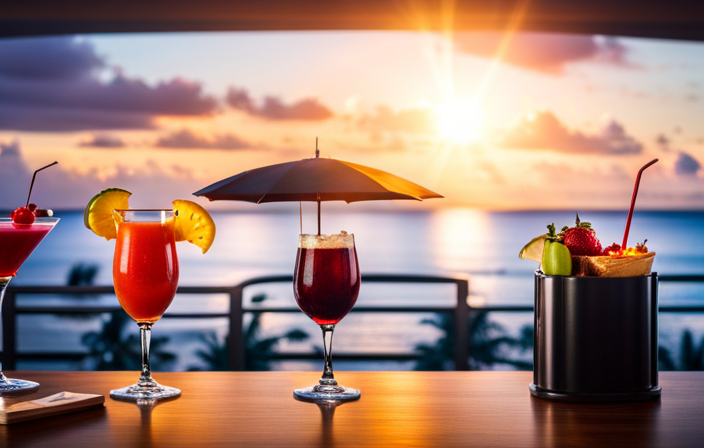
Hello, cruise enthusiasts! Are you prepared for a memorable voyage? Prepare to toast to good times ahead, as I bring to you the ultimate guide to the best cruise line beverage packages available. Believe me, these offers are truly revolutionary.
Picture this: unlimited cocktails, beers, and wines flowing freely throughout your entire vacation. That’s right, my friends, we’re talking about the ultimate drink packages offered by some of the most popular cruise lines in the world.
From MSC Cruises to Norwegian Cruise Line, and even Royal Caribbean, these packages have got you covered. Whether you prefer a classic cocktail or a cold brew, there’s something for everyone. And don’t worry, I’ve got all the details on prices, options, and even some insider tips to make the most of your drink package.
So grab your sunscreen and get ready to sip your way to paradise. This ultimate cruise line drink packages guide has got everything you need to know.
Cheers to an unforgettable vacation!
Key Takeaways
- MSC Cruises offers a range of alcohol drink packages, including the Easy Package, Easy Plus Package, and Premium Extra Package, with prices ranging from $46 to $88 per day.
- Norwegian Cruise Line offers the Unlimited Open Bar Package and the Premium Plus Package, with prices starting at $109 per person, per day.
- Royal Caribbean offers the Deluxe Beverage Package, Royal Refreshment Package, and Classic Soda Package, with prices ranging from $12.99 to $102 per person, per day.
- Virgin Voyages does not offer drink packages but has affordable prices for individual drinks, with beers averaging $5-$6 and most wines by the glass under $10.
Drink Package Options
I’ve found a variety of drink package options available on different cruise lines, including MSC Cruises, Norwegian Cruise Line, Royal Caribbean, and Virgin Voyages. When it comes to buying drink packages in advance, there are pros and cons to consider.
One advantage is that booking ahead can save you money, with discounts ranging from 10% to 40% compared to onboard pricing. This is especially true for Royal Caribbean, where buying in advance can lead to significant savings.
However, one downside is that the prices of drink packages can vary across different cruise lines. For example, MSC Cruises offers packages ranging from $46 to $88 per day, while Norwegian Cruise Line’s packages start at $109 per person, per day.
It’s important to compare the prices and offerings of each cruise line to find the best option for your preferences and budget.
MSC Cruises
MSC Cruises offers a variety of drink packages that cater to different preferences and budgets. Whether you’re looking for alcoholic or non-alcoholic options, MSC Cruises has got you covered. Let’s take a closer look at their drink package prices, benefits, and comparisons.
| Package Name | Price Range | Benefits |
|---|---|---|
| Alcohol-Free | N/A | Perfect for adults who prefer non-alcoholic drinks |
| Easy Package | $46 – $49 | Includes a selection of classic and international cocktails |
| Easy Plus Package | $61 – $64 | Includes all beverages up to $10, 10% off bottles of wine |
| Premium Extra | $85 – $88 | Includes all beverages up to $16, premium brands of spirits |
Booking in advance can save you up to 15% compared to onboard pricing. So, whether you’re looking for a refreshing mocktail or a premium glass of wine, MSC Cruises has a drink package that suits your needs.
Norwegian Cruise Line
Norwegian Cruise Line offers a variety of drink packages that cater to different preferences and budgets, providing a wide range of beverages from select cocktails to top-shelf spirits, unlimited soft drinks, and even Starbucks coffee.
When it comes to their drink packages, there are a few options to consider.
-
Unlimited Open Bar Package: This package is offered through the ‘Free at Sea’ promotion and includes select cocktails, spirits, beer, wine, unlimited soft drinks, and a 20% discount on bottles of wine and champagne. It offers great value for those who plan on enjoying a variety of alcoholic and non-alcoholic beverages throughout their cruise.
-
Premium Plus Package: For an additional $29 per person, per day, the Premium Plus Package can be upgraded from the Unlimited Open Bar Package. This upgraded package includes top-shelf cocktails, spirits, beer, champagne, wine, unlimited soft drinks, and Starbucks coffee. It is perfect for those who want to indulge in premium beverages and enjoy a luxurious drinking experience.
Is the Unlimited Open Bar Package worth the cost? The Unlimited Open Bar Package is definitely worth considering, especially if you plan on having several drinks throughout the day. With a wide selection of beverages included, it offers great value and convenience.
How does the Premium Plus Package compare to the Unlimited Open Bar Package? The Premium Plus Package offers an upgrade to the Unlimited Open Bar Package by providing access to top-shelf drinks and Starbucks coffee. If you’re a fan of premium spirits and want to enjoy specialty coffee, this upgrade is worth considering. However, if you’re content with the offerings of the Unlimited Open Bar Package, it may not be necessary to upgrade. Ultimately, the choice depends on your personal preferences and budget.
Pride of America
Virgin Voyages, on the other hand, doesn’t offer any drink packages.
Now let’s turn our attention to Pride of America. When it comes to drink packages, Pride of America offers one option for guests. Priced at $109 per person, per day, this package provides unlimited alcoholic beverages throughout your cruise.
While the price may seem steep, it’s important to consider the value you’ll be getting. With the package, you can enjoy a wide variety of cocktails, spirits, beer, wine, and more without worrying about the cost adding up.
When comparing the drink package options across different cruise lines, Pride of America’s package stands out as one of the best values. So if you’re someone who enjoys indulging in a few drinks while on vacation, this package is definitely worth considering.
Royal Caribbean
When it comes to planning my next cruise, I’m excited to explore the drink package options offered by Royal Caribbean. Royal Caribbean offers two main drink packages: the Deluxe Beverage Package and the Royal Refreshment Package.
Here’s a comparison of the pricing for these packages:
-
Deluxe Beverage Package: Prices range from $63 to $102 per person, per day. This package includes a wide variety of cocktails, beers, wines, soda, water, specialty teas and coffees, and juices.
-
Royal Refreshment Package: Prices range from $29 to $39 per person, per day. This package includes non-alcoholic cocktails, Coca-Cola Freestyle beverages, water, specialty teas and coffees, shakes, and juices.
Booking Royal Caribbean’s drink packages in advance has its benefits. Not only can you save money, with discounts ranging from 10% to 40%, but you can also ensure that you have your preferred package secured before your cruise. This way, you can start enjoying your favorite drinks as soon as you step onboard.
So, don’t miss out on the opportunity to enhance your cruise experience with Royal Caribbean’s drink packages.
Frequently Asked Questions
Are there any non-alcoholic drink package options available on MSC Cruises?
Yes, MSC Cruises offers non-alcoholic drink package options. The Easy Package includes a wide range of non-alcoholic beverages such as soft drinks, fruit juices, and hot drinks. This package is a great choice for adults who prefer non-alcoholic drinks.
Can the Unlimited Open Bar Package on Norwegian Cruise Line be used on any cruise ship within the fleet?
Yes, the Unlimited Open Bar Package on Norwegian Cruise Line can be used on any cruise ship within the fleet. It offers select cocktails, spirits, beer, wine, unlimited soft drinks, and a 20% discount on bottles of wine and champagne.
Is the alcoholic beverage package on Pride of America the only drink package option available?
No, the Pride of America offers one alcoholic beverage package, but there are other non-alcoholic drink options available on different cruise lines. It’s also important to compare the cost of drink packages on different cruise lines to find the best option for you.
Do the prices for drink packages on Royal Caribbean vary depending on the ship, itinerary, and sail date?
Yes, the prices for drink packages on Royal Caribbean do vary depending on the ship, itinerary, and sail date. These variations are influenced by factors such as demand, availability, and the level of inclusivity in the package.
Does Virgin Voyages offer any promotions or discounts for onboard beverages?
Unfortunately, Virgin Voyages does not offer any promotions or discounts for onboard beverages. However, for those looking for non-alcoholic options, MSC Cruises offers an Alcohol-Free Package for adults who prefer non-alcoholic drinks.
Alfons is the visionary leader and driving force behind Voyager Info’s success. As the Editor in Chief, he brings a wealth of experience and an unwavering passion for travel to the helm of our cruise-centric platform.
With a lifelong fascination for exploring new horizons, Alfons discovered his love for the ocean and cruising at a young age. From sailing across pristine Caribbean waters to embarking on daring expeditions to far-flung destinations, he has amassed a treasure trove of first-hand experiences in the world of cruising.
Onboard Experience
The Importance Of The Cruise Ship Muster Drill: A Vital Safety Briefing
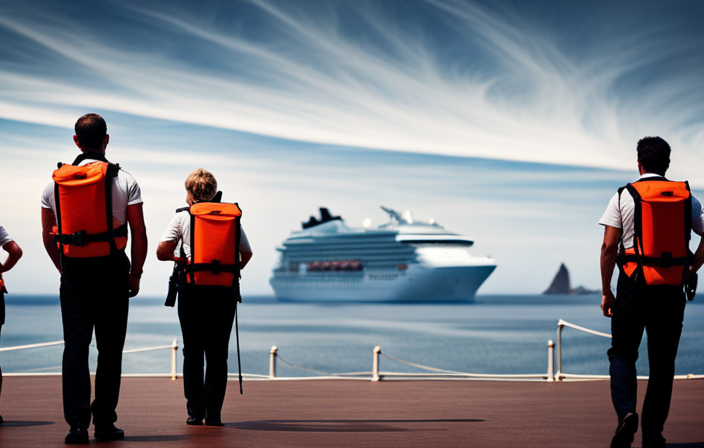
Stepping onto the magnificent cruise ship, I am filled with anticipation and excitement, eagerly looking forward to the upcoming adventure. The staff efficiently and skillfully readies the ship for its journey with synchronized precision.
But amidst the glamour and luxury, there is a crucial aspect that cannot be overlooked – the cruise ship muster drill. This safety briefing is like the foundation of a magnificent structure, ensuring that all passengers are prepared for any unexpected emergencies that may arise during our voyage. It is a vital ritual that every passenger must partake in, regardless of their previous cruising experience.
With two types of drills available – virtual and in-person – the cruise lines have adapted to meet the needs of their guests. From life jacket demonstrations to safety announcements, the muster drill equips us with the knowledge and confidence to navigate through any challenging situation.
So, as we set sail, let us not forget the importance of this essential safety briefing, for it is the compass that guides us towards a safe and enjoyable journey.
Key Takeaways
- The cruise ship muster drill is a required safety briefing that familiarizes passengers with assembly stations and protocols before sail away.
- There are two types of muster drills: virtual muster process where passengers watch safety briefings from smartphones or stateroom TV, and in-person drills where passengers head to designated stations and scan cruise cards for attendance.
- Key components of the muster drill include life jacket demonstrations, safety announcements, and an emergency signal blasted at the end of the drill.
- The muster drill is important because it ensures that passengers know where to go in case of a real emergency and is a result of the SOLAS treaty formed to prevent major incidents at sea. Missing the drill may result in being forced off the ship or denied a refund.
What is it?
The cruise ship muster drill is a required safety briefing that familiarizes passengers with assembly stations and protocols, even for those who’ve cruised before. Its importance can’t be overstated, as it serves a crucial purpose in ensuring the safety of all passengers on board.
The purpose of the muster drill is to educate passengers on what to do and where to go in case of a real emergency at sea. By participating in the drill, passengers are able to familiarize themselves with the location of their assembly station, learn how to properly wear a life jacket, and receive important safety announcements. This knowledge is vital in the event of an actual emergency, as it enables passengers to act quickly and efficiently, potentially saving lives.
Therefore, every passenger, regardless of their cruise experience, must attend the muster drill to ensure the safety and well-being of all on board.
Types of drills
Ironically, there are different methods available for passengers to familiarize themselves with emergency procedures on a cruise ship. Whether it’s through a virtual or in-person drill, the goal remains the same – ensuring passenger safety in the event of an emergency.
Here are four reasons why virtual drills have become increasingly popular:
-
Convenience: Virtual drills allow passengers to access safety briefings from the comfort of their stateroom or even their smartphones, eliminating the need to physically gather at designated stations.
-
Time-saving: With virtual drills, passengers can complete the safety briefing at their own pace, freeing up valuable time during the initial stages of the cruise.
-
Multilingual options: Virtual drills can easily accommodate international guests by offering safety briefings in multiple languages, ensuring everyone understands the emergency procedures.
-
Enhanced engagement: Virtual drills often utilize interactive elements, such as quizzes or videos, making the learning experience more engaging and memorable.
By embracing virtual drills, cruise lines are able to provide a more efficient and engaging safety briefing, ultimately ensuring the well-being of passengers in the event of an emergency.
Key components
Fortunately, the key components of the drill ensure that passengers are well-prepared for emergencies.
One important aspect is the life jacket demonstrations. During the muster drill, crew members demonstrate how to properly wear and secure a life jacket. This ensures that passengers understand the correct procedure in case of an emergency involving water.
Additionally, safety announcements are made to provide important information on emergency procedures and evacuation protocols.
Another factor to consider is the presence of international guests, which may lead to longer drill durations. Since different languages need to be accommodated, it takes more time to ensure that all passengers understand the instructions.
Overall, these key components of the muster drill play a crucial role in educating passengers about safety measures and ensuring their readiness in case of an emergency at sea.
Changes and requirements
Interestingly, amidst the changes and requirements, cruise lines have implemented a virtual format for the muster drill, allowing passengers to familiarize themselves with emergency protocols from the comfort of their own staterooms. This new format has brought about several important changes and requirements for passengers. Here are four key points to consider:
-
Muster drill changes:
- Some cruise lines switched to a virtual format during the pandemic.
- Norwegian ships returned to the e-muster drill format after guest feedback.
- The new format was well-received by guests.
- Most cruise lines don’t plan to revert back to the old system.
-
Muster drill requirements:
- Muster station visit and cruise card scan are still required on board.
- Crew members will track down those who miss the drill.
- Missing the drill may result in being forced off the ship or denied a refund.
- It can be annoying for others if some passengers miss the drill.
These changes and requirements reflect the cruise industry’s commitment to ensuring passenger safety and preparedness in the event of an emergency.
Virtual vs in-person drills
I prefer the convenience and ease of participating in a virtual drill rather than attending an in-person session. Virtual muster drills, offered by various cruise lines, have become increasingly popular among passengers.
There are both pros and cons to this new format. One of the main advantages is that passengers can watch safety briefings from their smartphones or stateroom TVs, allowing for flexibility and privacy. It eliminates the need to gather at a designated assembly station, saving time and reducing congestion. Additionally, virtual drills have been well-received by guests, providing a more comfortable learning environment.
However, some passengers may miss out on the hands-on experience of putting on a life jacket or physically locating their assigned muster station.
Ultimately, passenger preferences play a crucial role in determining the success of virtual versus in-person drills.
Frequently Asked Questions
Are children required to attend the muster drill?
Yes, children are required to attend the muster drill for their own safety and emergency preparedness. It is important for them to be familiar with the protocols and know where to go in case of a real emergency.
Can passengers bring their own life jackets to the muster drill?
Passengers may bring their own life jackets to the muster drill, but it is important to follow the cruise line’s life jacket regulations. These regulations ensure that all life jackets meet safety standards and are properly inspected.
What happens if a passenger misses the muster drill?
Missing the muster drill can lead to dire consequences. Safety measures are in place for a reason, and passengers who neglect them may face being forced off the ship or denied a refund.
How long does the muster drill typically last?
The duration of the muster drill varies depending on the cruise line and ship, but it typically lasts around 30 minutes. It is an important safety briefing that familiarizes passengers with emergency procedures and their assembly station.
Can passengers opt out of attending the muster drill?
Passengers cannot opt out of attending the muster drill, as it is a mandatory safety briefing for all passengers. However, there are safety exemptions and muster drill alternatives, such as virtual drills, offered by some cruise lines.
Alfons is the visionary leader and driving force behind Voyager Info’s success. As the Editor in Chief, he brings a wealth of experience and an unwavering passion for travel to the helm of our cruise-centric platform.
With a lifelong fascination for exploring new horizons, Alfons discovered his love for the ocean and cruising at a young age. From sailing across pristine Caribbean waters to embarking on daring expeditions to far-flung destinations, he has amassed a treasure trove of first-hand experiences in the world of cruising.
Onboard Experience
Are Cruises Worth The Convenience And Value?
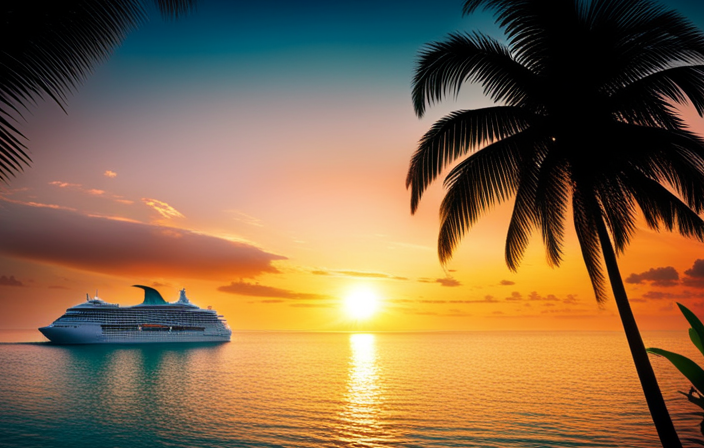
From the deck of the cruise ship, looking out at the immense ocean, I am struck by the convenience and worth offered by cruising. It seems like a mobile sanctuary, where only having to unpack once allows you to visit numerous destinations without the stress of constant moving.
The all-inclusive package, from lodging to food and entertainment, ensures that every need is taken care of. And the best part? It can be more affordable than traditional vacations, with prices as low as $40-$50 per day.
But are cruises truly worth it? That’s the question I aim to answer in this article. We’ll delve into the benefits and experiences that make cruises so appealing, as well as the cost and value they provide. We’ll also explore the downsides and limitations to consider.
So join me as we embark on this journey to determine if cruises are truly worth the convenience and value they promise.
Key Takeaways
- Cruises offer the convenience of unpacking once and visiting multiple destinations, making it a hassle-free vacation option.
- Cruises provide excellent value for money, with all-inclusive fares that cover lodging, transportation, food, entertainment, and activities.
- The onboard experience on cruises is top-notch, with high-quality food and a wide variety of entertainment options, including Broadway musicals and ice skating performances.
- However, there are some downsides and limitations to consider, such as the possibility of motion sickness, limited time in port for deep immersion in a city’s culture, and additional charges for tours, internet access, and alcohol.
Are cruises worth it?
I think cruises are definitely worth it because they offer convenience, value, and a variety of onboard experiences.
When it comes to convenience, one of the biggest advantages of cruising is the ability to unpack once and visit multiple destinations. It’s like having a floating resort that takes you to different places.
In terms of value, cruises can be quite cost-efficient, with fares typically including lodging, transportation, food, entertainment, and activities. However, it’s important to consider the drawbacks and limitations. Some people may experience motion sickness due to choppy seas, and the limited time in port may not allow for deep immersion in a city’s culture. Additionally, there may be additional charges for things like alcohol, internet access, and shore excursions.
Despite these limitations, the cruise ship amenities and the overall experience make cruises worth considering for a convenient and value-packed vacation.
Benefits and Experiences
Imagine exploring a new city each day, immersing yourself in different cultures, and indulging in a variety of world-class entertainment and cuisine, all while unpacking just once and effortlessly gliding through stunning ocean views. Cruising offers a unique and convenient way to experience multiple destinations while enjoying the comforts of a floating resort. The benefits of cruising include the convenience of unpacking once and visiting multiple destinations, the opportunity to see different countries and cities, and the cost-efficiency of having lodging, transportation, food, entertainment, and activities included in the cruise fare. However, there are downsides to consider, such as potential motion sickness, limited time in port, and additional expenses for tours, internet, and alcohol. To help you weigh the pros and cons of cruising, here is a handy table:
| Pros of Cruising | Cons of Cruising |
|---|---|
| Convenience of unpacking once | Potential motion sickness |
| Opportunity to visit multiple destinations | Limited time in port |
| Cost-efficient way to travel | Additional expenses for tours, internet, and alcohol |
| All-inclusive fares | Adherence to the cruise ship’s schedule |
By considering these factors, you can determine if the convenience and value of cruising align with your travel preferences and priorities.
Cost and Affordability
When considering the cost of a vacation, it’s important to note that cruises can be a more affordable option compared to all-inclusive resorts. While all-inclusive resorts offer a luxurious experience, they often come with a higher price tag.
On the other hand, cruises provide budget-friendly options and deals that make them an attractive choice for travelers looking to maximize their vacation budget. Cruise fares typically include lodging, transportation, food, entertainment, and activities, making them a cost-efficient way to explore multiple destinations. With prices as low as $40-$50 per day, including all essentials, cruises offer great value for your money. This makes it easier to plan and stick to a budget, without worrying about additional expenses adding up.
Moreover, cruises offer the convenience of unpacking once and visiting multiple destinations, allowing you to experience different cultures and see several countries and cities in one trip. This convenience, combined with the affordability, makes cruises a worthwhile option for those seeking a memorable and budget-friendly vacation.
Frequently Asked Questions
What are the safety measures taken on cruises to ensure the well-being of passengers?
Safety protocols and health measures on cruises are comprehensive. They include regular temperature checks, enhanced sanitation practices, social distancing measures, mandatory mask-wearing, and pre-boarding health screenings to ensure the well-being of passengers.
Are there any age restrictions for certain activities or amenities on the cruise ship?
Age restrictions vary for different activities and amenities on cruise ships. While some activities like casinos and bars have age restrictions, there are usually plenty of options available for all age groups to enjoy their vacation.
Can I bring my own alcohol or beverages onboard?
Yes, you can bring your own alcohol or beverages onboard, but there may be restrictions and fees. It’s important to check with the cruise line beforehand. If prohibited, there are alternative onboard activities to enjoy.
How do I handle medical emergencies while on a cruise?
Handling medical emergencies on a cruise is crucial. Ships have medical facilities with trained staff to provide assistance. They can handle common illnesses and injuries, but serious cases may require evacuation to a nearby hospital.
What are the environmental impacts of cruising and how do cruise lines address sustainability issues?
Cruise lines are increasingly aware of the environmental impacts of cruising and have implemented various sustainable practices. They adhere to environmental regulations, invest in eco-friendly technologies, reduce waste, and promote conservation efforts to minimize their ecological footprint.
Alfons is the visionary leader and driving force behind Voyager Info’s success. As the Editor in Chief, he brings a wealth of experience and an unwavering passion for travel to the helm of our cruise-centric platform.
With a lifelong fascination for exploring new horizons, Alfons discovered his love for the ocean and cruising at a young age. From sailing across pristine Caribbean waters to embarking on daring expeditions to far-flung destinations, he has amassed a treasure trove of first-hand experiences in the world of cruising.
-

 Cruise FAQs3 days ago
Cruise FAQs3 days agoHow To Turn On Cruise Control Tesla Model 3
-

 Cruise FAQs3 months ago
Cruise FAQs3 months agoWhat Is The Weather Like On A Transatlantic Cruise In April
-

 Cruise FAQs3 days ago
Cruise FAQs3 days agoHow To Set Cruise Control Tesla Model Y
-

 Cruise FAQs3 months ago
Cruise FAQs3 months agoHow to Contact Someone on a Carnival Cruise Ship
-
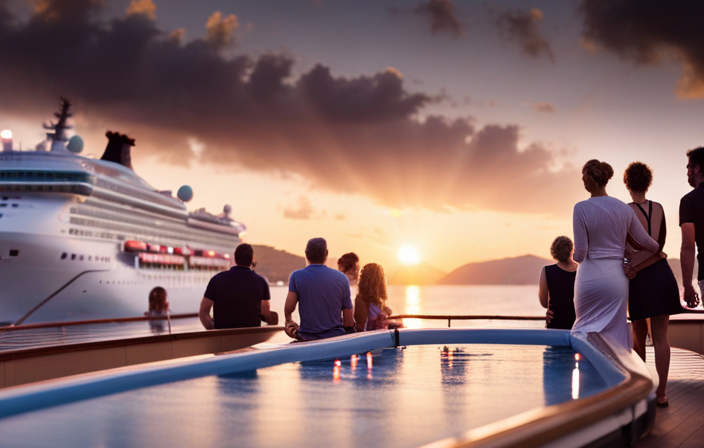
 Cruise Lines3 months ago
Cruise Lines3 months agoWhat Is The Average Age Of Passengers By Cruise Line
-

 Onboard Experience1 week ago
Onboard Experience1 week agoFinding Deals On Unsold Cruise Cabins: Tips And Strategies
-
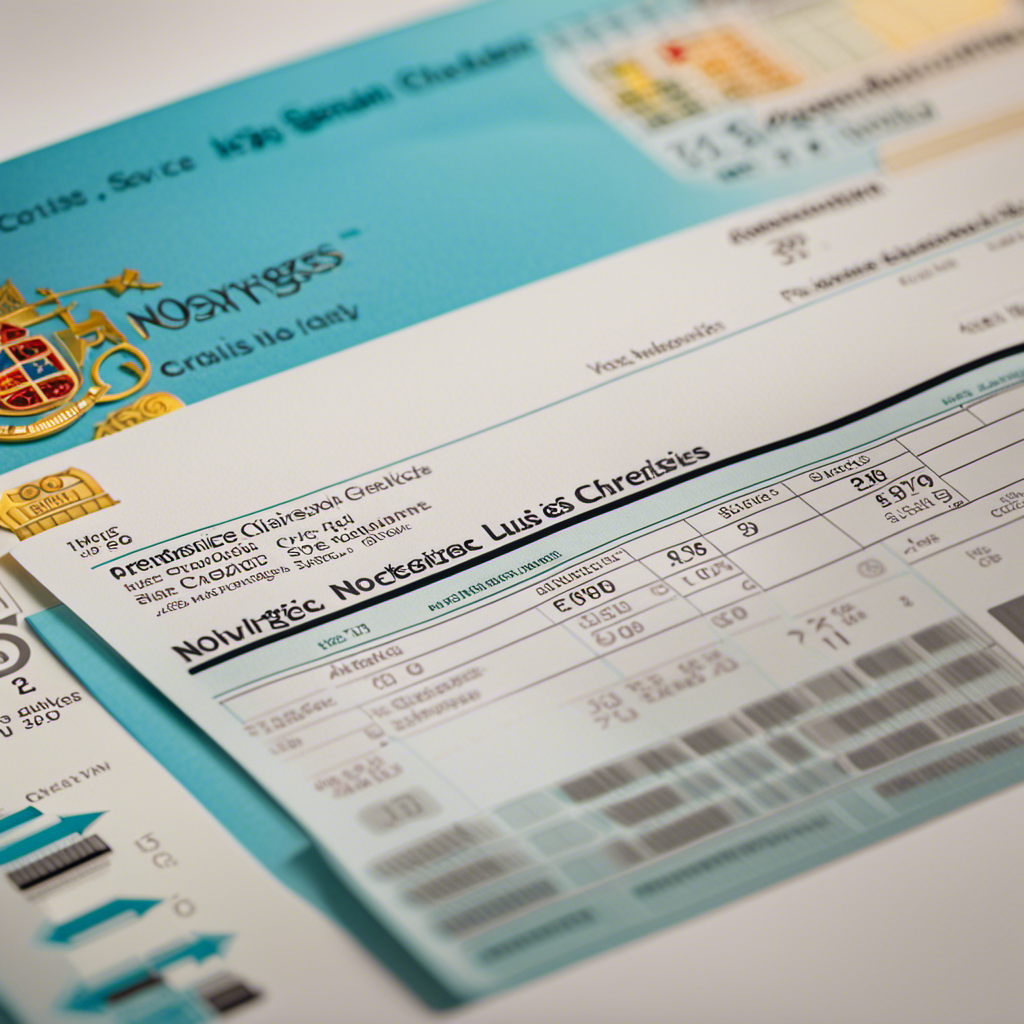
 Cruise Lines3 months ago
Cruise Lines3 months agoDecoding Norwegian Cruise Line’s Gratuities and Service Charges
-
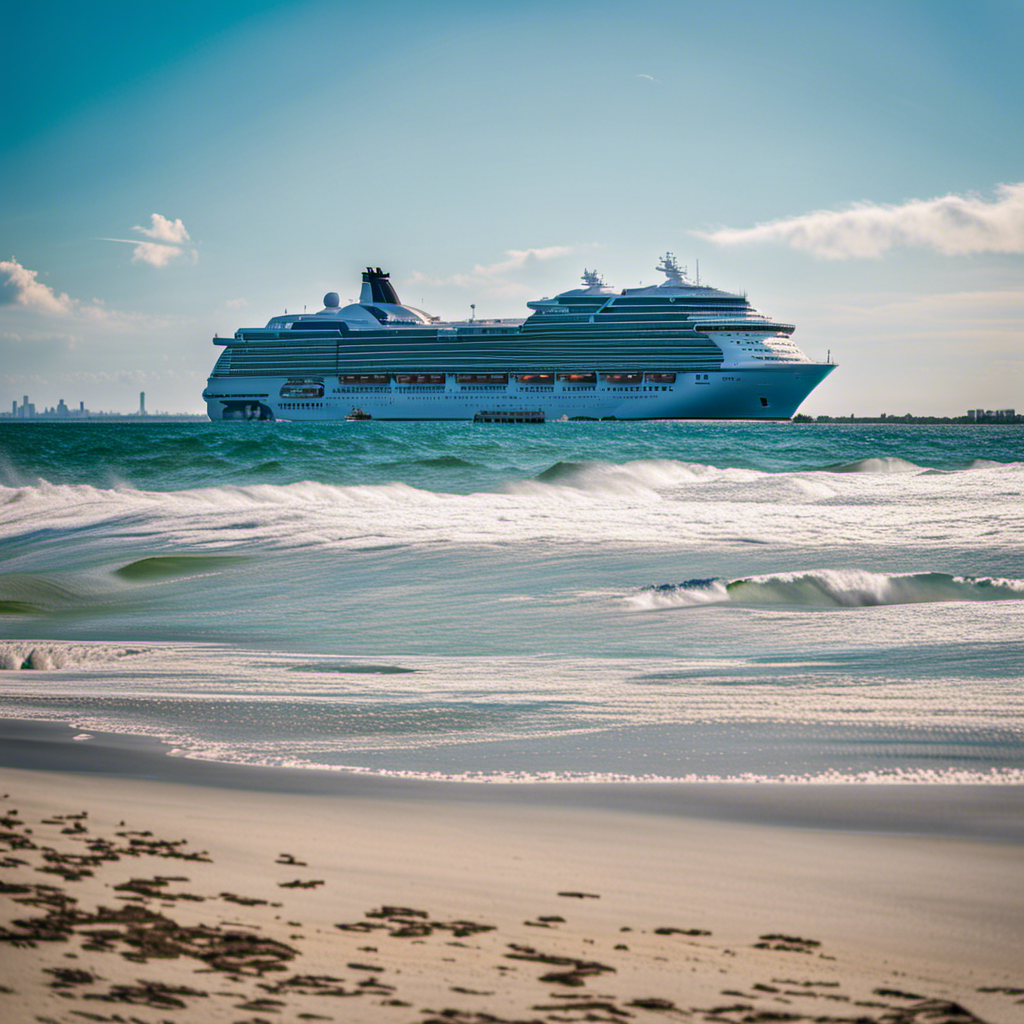
 Cruise Lines3 months ago
Cruise Lines3 months agoWhat Cruise Lines Depart From North Carolina







